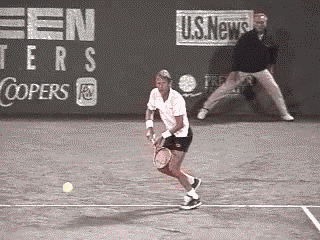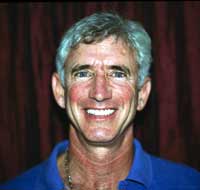|
TennisOne Lessons The Myth of the Open vs Closed Stance Forehands Jack Broudy There is a deep-seated assumption among teaching pros and players that there is a fundamental difference between the “open” and “closed” stance forehands. Although the foot positioning is slightly different on these two strokes, I will show you that they are in essence, the same. There is absolutely no difference in the orientation and set up of the hips and consequently the rest of the body, between the open and closed stances. Most great players consistently hit both of these shots equally well. And so should you. The first player I can remember who consistently hit the open-stance forehand was Bjorn Borg. He had the big Western grip, feet parallel to the net, and sported what we would call the first “whippy” forehand. Those of us watching were truly amazed. We were especially blown away because his style was contrasted against his more mechanical-looking peers, like Jimmy Connors, Stan Smith, and john McEnroe - all quite stiff and more conventional players. Originally, the open stance was used only by extreme Western grippers and big topspin hitters. Today, the open-stance forehand is the standard and is used by every player on the tour. It is an essential tool in today’s harder hitting, less time for recovery game. All players with all different grips use the shot, from Fabrice Santoro’s two-handed slice forehand to Rafael Nadal’s major topspin weapon. Using the open-stance allows players sufficient time to get ready for the next shot after finishing the last one. The open-stance not only saves two or three steps but it also puts the player into the ready position automatically.
At first glance, the rest of the tennis World, saw the Borg open-stance forehand as idiosyncratic and not something to be tried by the rest of us. It was so out of the norm, that we (coaches and commentators primarily) dismissed it as being only for the truly gifted, natural athletes. And in those days, that was Borg. As the years went on, we saw the truly gifted growing in numbers: Vilas, Moya, Mauresmo, Rios, Nadal, Roddick, Serena, and so on. In fact, as I mentioned earlier, every player today can, and does, hit the open-stance forehand. The “Difference” Is The Myth! Upon a closer look; however, the open-stance forehand is really not very different at all from the more conventional, closed stance shot. And that is because the foot position on the forehand is not nearly as important as the orientation of the hips and shoulders to the ball before, during, and after the hit. Every good player sets up relatively the same way with regards to the center of the body. And when they miss-fire, it’s generally because they have not lined up the hips properly from the start. A great example of that could be seen last year when Roger Federer was having some difficulties with his forehand. Occasionally, Roger would not line up his hips at a 45º angle to the net. Instead, he was facing his hips more “open” towards the net. This would sometimes cause him to dump his crosscourt forehand into the bottom of the net, by hitting “too early.” The “set up” and “follow through” of the stroke are more about lining up the hips then the actual setup of the feet. It is my contention that the 45º angle to the net is the optimum contact point of every stroke for two reasons. First, it gives one the optimal view of the oncoming ball. The body poised at the 45º angle is in the same position as that of an archer or rifleman taking aim at a target. Second, it is the best point of contact, geometrically speaking. Hitting the ball in front of the 45º is “too early” and will result in the ball hitting the net. Striking the ball behind the 45º will cause a “late hit”, resulting in less power and probable arm and shoulder injuries down the road. The 45º angle is the most balanced point in any athletic stroke. It is also the “catch and release” point of a short-stop in baseball. The best ball-strikers in the world all hit the ball at the 45º angle to the net. Go through the lesson library and take a look for yourself. Therefore, when a player lines up his/her hips accordingly, right from the “get go,” he/she will hit their best forehand (or backhand, for that matter). It’s the “coil” and not the foot positioning that matters most. Let’s take a look at some of today’s top players to see just how this plays out.
As I look through the tennis one video gallery, I can’t help but notice that every forehand I see illustrates this point. As you watch these videos, notice how every player aligns the hips at a 45° angle to the net immediately, as they prepare for each forehand. Whether the stance is open, closed, or their feet are completely off the ground, you can see how every player locates this 45° angle with the hips as they position to the ball. Three Examples In this article I have chosen three of the top players in the game to examine, Rafael Nadal, Serena Williams, and Andy Murray. Notice how on all their forehands their hips are relatively in the same position as they draw the ball into the strike zone. Here are three completely different players, with opposite styles, all with the same set up fundamentals—open and/or closed stances. Rafa In the first example, Raphael Nadal hits both the open and closed stance forehands, one after another. Notice how on both of these strokes his hip orientation to the ball is identical. The moment Rafael sees the ball hit he immediately turns his hips towards the 45° angle. Upon doing so, his feet move appropriately beneath him. It is more in his knee bend and “screwing down into the court” that situates his hips accordingly. On a deeper forehand, he chooses to hit with an open-stance, where on the shorter forehand his feet naturally close as he steps into the court. As I said earlier, all the great players today can, and do hit equally as well, with the open or closed stance stroke. Serena Williams
In both of these forehands, (open and closed stances) watch how Serena quickly hops into her “line up” to the hit. She locates the contact point first, with her hips facing the 45º angle. The reason she "steps in” (right) is circumstantial. The ball is short enough, and moving slow enough which gives her time to take a natural step. Andy Murray
On both Andy Murray’s open and closed stance forehands he comes out of his split step and almost instantaneously buckles his left knee, pivoting his hips towards his eventual hitting point. His hands are relaxed and still “triangulated” in front of his hips as he sets his aim at the oncoming ball. He also takes the step in, when the ball lands shorter in the court (right). The important thing to notice is that in all four of the videos above, both players align their hips to the 45° angle immediately upon landing from the split step regardless of whether it's in an open on closed stance forehand. Primarily, the choice to hit open or closed stance, is a quick decision, based on balance and comfort factors. If the ball lands a little short in the court, most players will want to take the step and close their stance to the net. If the ball is taken deeper, (especially high balls,) most pros prefer to hit with an open stance. What you can, and should, take away from this is that the moment the ball is hit to you, immediately line up the hit by turning your hips to a 45º angle to the net. The feet will position themselves automatically, depending on the depth and speed of the ball. Line up the center of your body to the “perfect” (geometrically speaking) “hitting point” and you will have far more success than merely being “open” or “closed.” Those are just “buzz words” for players, coaches, and commentators to impress you with. As illustrated by the best players in the World, there is fundamentally, no real difference between the open and closed stance forehands! Your comments are welcome. Let us know what you think about Jack Broudy's article by emailing us here at TennisOne.
8Board Tennis SystemIf any of my articles regarding the nonlinear game and the 8Board® Tennis System strike a chord in you, or you’d like to learn more, please send along your comments and visit 8boardtennis.com. If you’re also a golfer please visit 8boardgolf.com.
|

